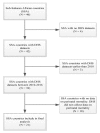Perinatal Mortality in Sub-Saharan Africa: A Meta-Analysis of Demographic and Health Surveys
- PMID: 31298820
- PMCID: PMC6634369
- DOI: 10.5334/aogh.2348
Perinatal Mortality in Sub-Saharan Africa: A Meta-Analysis of Demographic and Health Surveys
Abstract
Background: Sub-Saharan Africa (SSA) has one of the highest levels of perinatal mortality globally. However, there are sub-regional and country-specific disparities in its distribution.
Objective: The aim of this study was to undertake a meta-analysis of demographic and health surveys to quantify perinatal mortality rate within sub-Saharan Africa and to depict sub-regional and country-specific differences.
Methods: This study used cross-sectional data from the most recent demographic and health surveys (2010-2016) conducted in 21 sub-Saharan African countries. The countries were grouped into four sub-regions (Eastern Africa, Western Africa, Southern Africa and Central Africa), and a meta-analysis was conducted to estimate perinatal mortality rate within each of the sub-regions. Significant heterogeneity was detected among the various surveys (I2 > 50%), hence a random effect model was used. Sensitivity analysis was also performed to examine the effects of outliers. Perinatal mortality was defined as pregnancy losses occurring after seven completed months of gestation (stillbirths) and deaths to live births within the first seven days of life (early neonatal deaths).
Findings: The pooled estimate for perinatal mortality rate per 1000 births across 21 countries in the four sub-regions of SSA was 34.7 (95% CI: 32.6, 36.8). Eastern Africa reported 34.5 (95% CI: 32.2, 36.8), with the highest rate observed in Tanzania [39.5 (95% CI: 35.8, 43.4)]. Western Africa reported 35.7 (95% CI: 32.2, 39.3), with the highest rate observed in Nigeria [40.9 (95% CI: 38.3, 43.2)]. Southern Africa reported 30.3 (95% CI: 26.5, 34.0), with the highest rate observed in Lesotho [49.6 (95% CI: 42.3, 57.8)]. Central Africa reported 30.7 (95% CI: 28.0, 33.3), with the highest rate observed in Equatorial Guinea [37.3 (95% CI: 30.5, 45.1)].
Conclusions: To reduce mortality in the perinatal period, interventions should focus on improving access to high quality antenatal and postnatal care, as well as strengthening health care systems within countries in sub-Saharan Africa.
© 2019 The Author(s). This is an open-access article distributed under the terms of the Creative Commons Attribution 4.0 International License (CC-BY 4.0), which permits unrestricted use, distribution, and reproduction in any medium, provided the original author and source are credited. See http://creativecommons.org/licenses/by/4.0/.
Conflict of interest statement
The authors have no competing interests to declare.
Figures
References
-
- World Health Organization. Neonatal and perinatal mortality: Country, regional and global estimates Geneva, Switzerland: World Health Organization; 2006.
-
- World Health Organization. 2018 Progress Report: Reaching every newborn national 2020 milestones World Health Organization; 2018. March.
-
- National Population Commission [Nigeria] and ICF International. Nigeria Demographic and Health Survey 2013 Abuja, Nigeria and Rockville, Maryland, USA: NPC and ICF International; 2014.
Publication types
MeSH terms
LinkOut - more resources
Full Text Sources
Research Materials
Miscellaneous



